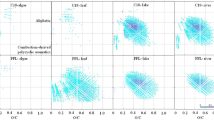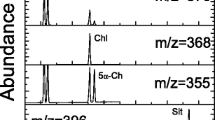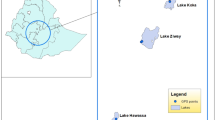Abstract
The efficiencies of conventional extraction techniques and analytical methods (HPLC–DAD and ELISA) were investigated for analyses of microcystins (MCs) in sediments. Our results showed several limitations. First, the extraction efficiency strongly depends on the extraction solvent, and extraction with 5% acetic acid in 0.2% trifluoroacetic acid (TFA)–methanol was confirmed as being the most appropriate for three different sediments (recovery: 33.1–44.9% of total MCs according to HPLC analyses). Second, the recovery of MCs was affected by the type of sediment but did not clearly correlate with the content of organic carbon. These results suggest that the sorption of MCs onto inorganic materials such as clay minerals is probably a more important process than interactions of the MCs with organic sediment matter. Third, the structure of the MCs is another crucial factor that affects the sorption of MCs and their recovery from sediments. Hydrophilic MC-RR gave much lower recoveries (20.0–38.8%) than MC-YR (44.1–59.5%) or MC-LR (55.3–77.8%) from three different types of spiked sediments. Recovery results analysed with HPLC–DAD correlated well with ELISA analyses. Further, extraction with 5% acetic acid in 0.2% TFA–methanol was used for analyses of MCs in 34 natural sediment samples collected from Brno reservoir (Czech Republic) from April to October 2005. Concentrations of MCs in sediments ranged from 0.003 to 0.380 μg/g sediment d.m. (ELISA results) or 0.016–0.474 μg/g d.m. (HPLC results). These values are equivalent to 0.63–96.47 μg/L of sediment (ELISA) or 4.67–108.68 μg/L (HPLC), respectively. Concentrations of sediment MCs showed both temporal and spatial variability, with the highest MC contents observed in the spring (April and May) and the lowest concentrations in July and August. Our results demonstrate the suitability of the methods described here for studying the occurrence, fate and ecological role of MCs in the aquatic environment.





Similar content being viewed by others
References
Svrcek C, Smith DW (2004) J Environ Eng Sci 3:155–185
de Figueiredo DR, Azeiteiro UM, Esteves SM, Goncalves FJM, Pereira MJ (2004) Ecotox Environ Safe 59:151–163
Duy TN, Lam PKS, Shaw GR, Connell DW (2000) Rev Environ Contam Toxicol 163:113–186
Codd GA, Morrison LF, Metcalf JS (2005) Toxicol Appl Pharmacol 203:264–272
Dietrich D, Hoeger S (2005) Toxicol Appl Pharmacol 203:273–289
WHO (1998) Guidelines for drinking water quality. World Health Organisation, Geneva
Kaebernick M, Neilan BA (2001) FEMS Microbiol Ecol 35:1–9
Perez S, Aga DS (2005) Trends Anal Chem 24:658–670
Pietsch J, Bornmann K, Schmidt W (2002) Acta Hydrochim Hydrobiol 30:7–15
Zheng L, Xie P, Li YL, Yang H, Wang SB, Guo NC (2004) Bull Environ Contam Toxicol 73:698–706
Pearson LA, Hisbergues M, Borner T, Dittmann E, Neilan BA (2004) Appl Environ Microbiol 70:6370–6378
Rapala J, Lahti K, Sivonen K, Niemela SI (1994) Lett Appl Microbiol 19:423–428
Jones G, Bourne DG, Blakeley RL, Doelle H (1994) Nat Toxins 2:228–235
Cousins IT, Bealing DJ, James HA, Sutton A (1996) Water Res 30:481–485
Christoffersen K, Lyck S, Winding A (2002) Aquat Microb Ecol 27:125–136
Hyenstrand P, Rohrlack T, Beattie KA, Metcalf JS, Codd GA, Christoffersen K (2003) Water Res 37:3299–3306
Saito T, Sugiura N, Itayama T, Inamori Y, Matsumura M (2003) Environ Technol 24:143–151
Holst T, Jorgensen NO, Jorgensen C, Johansen A (2003) Water Res 37:4748–4760
Babica P, Blaha L, Marsalek B (2005) Environ Sci Pollut Res 12:369–374
Welker M, Steinberg C (1999) Water Res 33:1159–1164
Welker M, Steinberg C (2000) Env Sci Technol 34:3415–3419
Mazur H, Plinski M (2001) Oceanologia 43:329–339
Miller MJ, Critchley MM, Hutson J, Fallowfield HJ (2001) Water Res 35:1461–1468
Saitou T, Sugiura N, Itayama T, Inamori Y, Matsumura M (2003) J Water Supply Res Technol–Aqua 52:13–18
Ishii H, Nishijima M, Abe T (2004) Water Res 38:2667–2676
Imanishi S, Kato H, Mizuno M, Tsuji K, Harada K (2005) Chem Res Toxicol 18:591–598
Jones GJ, Orr PT (1994) Water Res 28:871–876
Ihle T, Jähnichen S, Benndorf J (2005) J Phycol 41:479–488
Dittmann E, Erhard M, Kaebernick M, Scheler C, Neilan BA, von Dohren H, Borner T (2001) Microbiol–SGM 147:3113–3119
Kehr JC, Zilliges Y, Springer A, Disney MD, Ratner DD, Bouchier C, Seeberger PH, de Marsac NT, Dittmann E (2006) Mol Microbiol 59:893–906
Kankaanpaa HT, Sipia VO, Kuparinen JS, Ott JL, Carmichael WW (2001) Phycologia 40:268–274
Kankaanpaa HT, Holliday J, Schroder H, Goddard TJ, von Fister R, Carmichael WW (2005) Toxicol Appl Pharm 203:243–256
Tsuji K, Masui H, Uemura H, Mori Y, Harada K (2001) Toxicon 39:687–692
Grover R (eds) (1988) Environmental chemistry of herbicides. CRC Press, Boca Raton, FL
Zeck A, Weller MG, Bursill D, Niessner R (2001) Analyst 126:2000–2007
Zeck A, Eikenberg A, Weller MG, Niessner R (2001) Anal Chim Acta 441:1–13
De Maagd PGJ, Hendriks AJ, Seinen W, Sijm D (1999) Water Res 33:677–680
Barco M, Lawton LA, Rivera J, Caixach J (2005) J Chromatogr A 1074:23–30
Oliveira ACR, Magalhaes VF, Soares RM, Azevedo S (2005) Environ Toxicol 20:126–130
Morris RJ, Williams DE, Luu HA, Holmes CFB, Andersen RJ, Calvert SE (2000) Toxicon 38:303–308
Miller MJ, Fallowfield HJ (2001) Water Sci Technol 43:229–232
Rivasseau C, Martins S, Hennion MC (1998) J Chromatogr A 799:155–169
Tsujimura S, Tsukada H, Nakahara H, Nakajima T, Nishino M (2000) Hydrobiologia 434:183–192
Acknowledgements
Research has been supported by the Grant Agency of the Czech Republic (206/03/1215), by project AVOZ60050516 granted to the Institute of Botany, and by the Ministry of Education of the C.R. (1M6798593901). We thank Lenka Šejnohová, M.Sc., Hana Slováčková, M.Sc. and Mrs. Martina Sadílková for their invaluable help with sediment sampling.
Author information
Authors and Affiliations
Corresponding author
Rights and permissions
About this article
Cite this article
Babica, P., Kohoutek, J., Bláha, L. et al. Evaluation of extraction approaches linked to ELISA and HPLC for analyses of microcystin-LR, -RR and -YR in freshwater sediments with different organic material contents. Anal Bioanal Chem 385, 1545–1551 (2006). https://doi.org/10.1007/s00216-006-0545-8
Received:
Revised:
Accepted:
Published:
Issue Date:
DOI: https://doi.org/10.1007/s00216-006-0545-8




